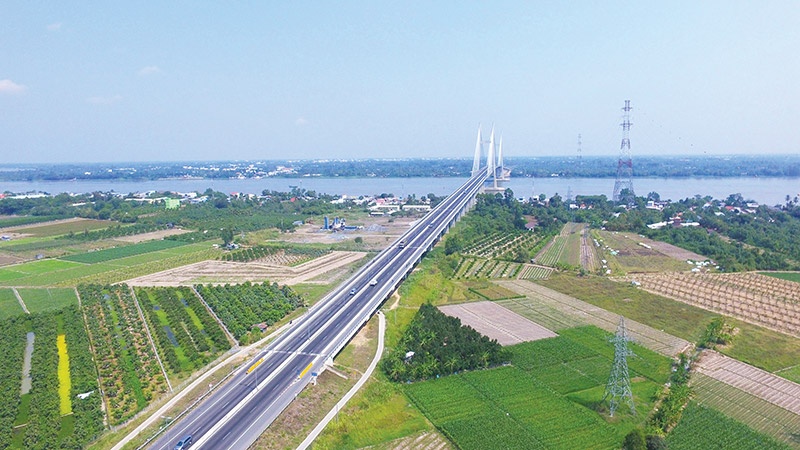Hallmark development plan draft sets out long-term goal
 |
| The upcoming plan will take into account all regions of the country, from urban areas to the mountains, Le Toan |
The first outline of the national development master plan for 2021-2030 was revealed last week, with the plan to be completed by the Ministry of Planning and Investment (MPI) and submitted to the National Assembly at a meeting in October-November.
“This master plan is a strategic document to re-order and restructure the national planning space based on the potential and strength of the country for rapid and sustainable socioeconomic development,” said Deputy Minister of Planning and Investment Tran Quoc Phuong.
In the view of Phuong, one of the most important concepts of the plan is to develop the country on a unified level, rather than divided along administrative boundaries, while all resources of the country are mobilised and used effectively.
Therefore, the national development space will be formed based on economic areas and corridors, strategic urban and economic centres, and connected infrastructure.
Tran Hong Quang, director general of the MPI’s Development Strategy Institute, said, “We will select some of the key economic regions at present that have the most favourable locations for international airports and seaports, sci-tech and innovation, and high-quality human resources to become the key motivation economic areas for the country.”
Quang added that while there are six socioeconomic regions currently, the 2021-2030 master plan proposes re-organisation into seven socioeconomic regions. “Every region has its own advantages and strengths in combination with its location, roles, and function to build a direction in line with the development of industries, economic zones, and infrastructure,” said Quang.
In addition to highly appreciating the draft of the national master plan, some experts expected that it would be revised further. According to Vu Nang Dung from the Vietnam Soil Science Association, coastal/maritime, delta and low-lying areas, and mountainous regions should all be cultivated and developed on a level playing field.
“It is quite difficult to build a master plan that integrates everything,” Dung said, “But we should identify regional development and vertical development instead of focusing on the current six socioeconomic regions,” urged Dung.
Dang Viet Dung, chairman of the Vietnam Federation of Civil Engineering Associations, said that economic corridors are a new concept, so some criteria need to be pointed out. “In addition to the basic traffic routes, we should analyse resources, human resources, and the strength of every region in order to develop economic corridors properly,” he said.
Meanwhile, Nguyen Quang, former director of the UN-Habitat Vietnam Programme, said that the building of the country’s master plan needs a cross-disciplinary approach like other countries are carrying out. “The plan should clarify the priorities and the solutions for these priorities. This is an approach that needs multi-industrial support to point out issues, build, and carry out the master plan,” said Quang.
For example, the second National Physical Plan 2011-2020 in Malaysia organised the country into four regions, three main development corridors, and four sub-development corridors.
In Indonesia, its Economic Master Plan for 2011-2025 highlighted six economic corridors that contribute over 80 per cent of the country’s GDP, including Sumatra for its resource production and national energy centre, Bali-Nusa for tourism and food support, and Papua-Kepulauan for the development of agriculture, energy, and mining.
What the stars mean:
★ Poor ★ ★ Promising ★★★ Good ★★★★ Very good ★★★★★ Exceptional
Related Contents
Latest News
More News
- Global partnerships key to Vietnam’s IFC development (December 26, 2025 | 16:18)
- Vingroup pulls out of bid to invest in North-South high-speed railway (December 26, 2025 | 11:42)
- Strengthening supply chains through trade promotions and customs reform (December 24, 2025 | 14:00)
- PM orders investment model for North–South high-speed rail (December 22, 2025 | 17:43)
- LS Eco Energy to invest in Vietnam rare earth sector (December 22, 2025 | 17:31)
- Government moves to establish International Financial Centre (December 21, 2025 | 21:00)
- Vietnam's IFC to target global investment flows (December 21, 2025 | 18:00)
- Two national hospitals expand capacity with new facilities (December 20, 2025 | 09:00)
- Ha Tinh breaks ground on major Vingroup industrial and energy projects (December 19, 2025 | 18:24)
- EVN launches major power infrastructure projects nationwide (December 19, 2025 | 18:17)

 Tag:
Tag:





















 Mobile Version
Mobile Version